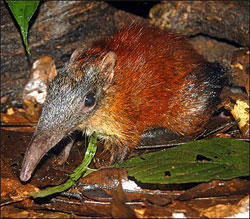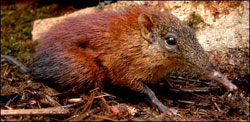 Click To Return To Main Page |
 |
||||||||
 News |
 Eco-Journalists |
 Articles |
 Games |
 Links |
 Facts 'n Fun |
 Email Us |
 About Us |
 Guestbook |
|
|
What do you get if you cross a Mouse with an Elephant?
Rhynochocyon Udzungwensis
 Although there may be thousands and thousands of living animals on this earth, you can now say there is thousands and thousands plus one. Dr. Rathbun, a scientist in Tanzania (pronounced 'Tan-zer-ne-a') in Africa have recently discovered a new animal dubbed 'Rhynochocyon Udzungwensis', also known as a 'Sengi'. This cat-sized animal looks like looks like a cross between a miniature antelope and a small anteater. It has a grey face, a long, flexible snout, a bulky, amber body, a jet-black rump and it stands on small, spindly legs.
Although there may be thousands and thousands of living animals on this earth, you can now say there is thousands and thousands plus one. Dr. Rathbun, a scientist in Tanzania (pronounced 'Tan-zer-ne-a') in Africa have recently discovered a new animal dubbed 'Rhynochocyon Udzungwensis', also known as a 'Sengi'. This cat-sized animal looks like looks like a cross between a miniature antelope and a small anteater. It has a grey face, a long, flexible snout, a bulky, amber body, a jet-black rump and it stands on small, spindly legs.
Dr. Rathbun said: "This is one of the most exciting discoveries of my career" and that "They are so bizarre-looking and a lot of their behavioural ecology is so unique and interesting, you kind of get wrapped up with them" Despite it's name; the elephant shrew, it is not actually related to the 15 other types of elephant shrews. Elephant shrews are only found in Africa. This cute little animal is actually more closely related to groups of African mammals,like elephants, manatees, aardvarks and hyraxes, as it shares a 'common ancestor with them' about 100 million years ago. That means that 100 million years ago, this elephant shrew had the same great, great, great, great...(you get the drift) grandfather and grandmother as the african mammals, but they have evolved differently to suit their habitat.  It uses its long snout for scooping up insects,mostly termites, much like it relative, the ant eater. It has a grey face, a black rump, weighs about 700g and measures about 30cm in length. (That's the length of your ruler for school!)
It uses its long snout for scooping up insects,mostly termites, much like it relative, the ant eater. It has a grey face, a black rump, weighs about 700g and measures about 30cm in length. (That's the length of your ruler for school!)
The new animal was first caught on film in 2005 in 'Ndundulu Forest' in Tanzania's Udzungwa Mountains by a camera trap set by Francesco Rovero, from the Trento Museum of Natural Sciences in Italy. Dr Rathbun said: "I got these images, and said to myself: 'Boy, these look strange'. "But you can't describe something new based just on photographs, so in March 2006, we went back in and collected some specimens." Sure enough, those specimens proved that the 'Rhynochocyon Udzungwensis' is in fact a new creature. We can only wonder what new wonderful animals that nature will bring us, so we just have to keep looking. Story by: Imogen Wadlow Information from: www.news.bbc.co.uk/ Illinois Natural History Survey: www.inhs.uiuc.edu Images from: http://palaeoblog.blogspot.com/2008/02/rhynochocyon-udzungwensis-new-tanzanian.html www.ultraorange.net |